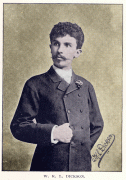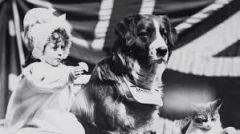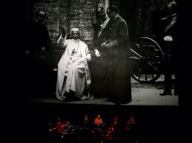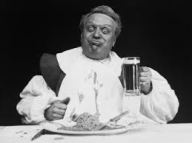BFI Southbank, London
11 May 2019
 How often is it that you can say ‘I went to the cinema tonight and saw 51 films’, But that is just what we did tonight, courtesy of the BFI’s Great Victorian Moving Picture Show. In fact, we actually saw 52, because there was an additional bonus of a ‘not seen in the UK for over a century’ film exclusive . This event was first staged at the London Film Festival last year in the BFI’s giant IMAX cinema, which I sadly missed, so this was a welcome opportunity to catch up with it at a re-screening intended to publicise the release on the BFI’s I-Player of an additional 500 digitally restored films made during the late Victorian era (1897-1901).
How often is it that you can say ‘I went to the cinema tonight and saw 51 films’, But that is just what we did tonight, courtesy of the BFI’s Great Victorian Moving Picture Show. In fact, we actually saw 52, because there was an additional bonus of a ‘not seen in the UK for over a century’ film exclusive . This event was first staged at the London Film Festival last year in the BFI’s giant IMAX cinema, which I sadly missed, so this was a welcome opportunity to catch up with it at a re-screening intended to publicise the release on the BFI’s I-Player of an additional 500 digitally restored films made during the late Victorian era (1897-1901).
While those 700 or so films comprise a variety of different formats, the focus of tonight’s event was primarily on a 68mm format designed by William Kennedy-Laurie  Dickson, a British engineer who had gone to America to work with Thomas Edison in developing moving picture technology. Returning to Britain and working for the British Mutoscope and Biograph Company, Dickson
Dickson, a British engineer who had gone to America to work with Thomas Edison in developing moving picture technology. Returning to Britain and working for the British Mutoscope and Biograph Company, Dickson  developed a film and projection system based upon 68mm film-stock (very close to contemporary IMAX size). Intended in part to avoid questions of patent infringement with the Edison company this much larger gauge film-stock also had the advantage of producing films of far greater quality than existing gauges (much as, for example, the venerable V2000 videotape format was infinitely superior to VHS but ultimately failed to win the commercial acceptance battle).
developed a film and projection system based upon 68mm film-stock (very close to contemporary IMAX size). Intended in part to avoid questions of patent infringement with the Edison company this much larger gauge film-stock also had the advantage of producing films of far greater quality than existing gauges (much as, for example, the venerable V2000 videotape format was infinitely superior to VHS but ultimately failed to win the commercial acceptance battle).
 Hosting this evening’s event, Bryony Dixon, the BFI’s curator of silent film, took us briefly through the evolution of film projection, from the days of exhibited painted panoramas through to the development of Dickson’s large format film. Then it was time to see the films themselves. Few were longer than 90 seconds due, I think, to the lack of sprocket holes in the negative film which limited the length of film-stock which could be pulled through the camera (although I could be totally wrong on this!). However, many of the clips were much shorter, often with only fragments of the originals surviving.
Hosting this evening’s event, Bryony Dixon, the BFI’s curator of silent film, took us briefly through the evolution of film projection, from the days of exhibited painted panoramas through to the development of Dickson’s large format film. Then it was time to see the films themselves. Few were longer than 90 seconds due, I think, to the lack of sprocket holes in the negative film which limited the length of film-stock which could be pulled through the camera (although I could be totally wrong on this!). However, many of the clips were much shorter, often with only fragments of the originals surviving.
But once seen, some of these films were unforgettable. In subject matter, they covered virtually the entire gamut of Victorian life, from entertainment to warfare, from royalty to factory work, from travel to advertising. Perhaps the shortest clip was just four seconds long, with a small child trying to  feed a biscuit to the Worthing lifeboat crew’s dog (1898). Shown on a repeat loop it is altogether charming, of incredible clarity but ultimately deeply frustrating because you just know that no matter how many times the film is screened the dog is never going to get that biscuit. A longer clip (also 1898) shows the lifeboat coming ashore on a training exercise and a ‘casualty’ being carried onto the beach. But he is carried too far, going out of camera shot, so you can imagine the cameraman screaming frantically to bring him back into shot so we can see the subsequent first-aid.
feed a biscuit to the Worthing lifeboat crew’s dog (1898). Shown on a repeat loop it is altogether charming, of incredible clarity but ultimately deeply frustrating because you just know that no matter how many times the film is screened the dog is never going to get that biscuit. A longer clip (also 1898) shows the lifeboat coming ashore on a training exercise and a ‘casualty’ being carried onto the beach. But he is carried too far, going out of camera shot, so you can imagine the cameraman screaming frantically to bring him back into shot so we can see the subsequent first-aid.
Then there is an Ashes cricket match with the Australian captain leading his team out onto the field (1899) and it quickly becomes obvious that the Merv Hughes moustache was in fashion amongst Australian cricketers as far back as the Victorian era. Industry was another popular subject with iron foundry workers in Newcastle (1900) shown enduring the harshest conditions, even wearing platform sole boots so they could walk over the still hot metal ingots they were producing. Let no-one say  that today’s health and safety regulations don’t serve a purpose! Then there was the launch of the liner Oceania at Harland and Wolfe shipyard in Belfast (1899). This clip in particular highlighted the stunning quality of 68mm film-stock, with every plate on the ship’s hull visible as it slid into the water, the force of the water gently turning its screws and the chains straining to hold it from drifting out too far.
that today’s health and safety regulations don’t serve a purpose! Then there was the launch of the liner Oceania at Harland and Wolfe shipyard in Belfast (1899). This clip in particular highlighted the stunning quality of 68mm film-stock, with every plate on the ship’s hull visible as it slid into the water, the force of the water gently turning its screws and the chains straining to hold it from drifting out too far.
As might be expected, there was also plenty of Victorian royalty on display, from a family get together in Helsingor in Denmark (ie the crowned heads of Europe, 1901), with a somewhat rotund  Edward VII the ‘host with the most’, to an afternoon tea with Queen Victoria at Clarence House (1897). But amongst shots of royalty, Bryony pointed out that the main absence was any clear footage of Victoria herself. Either she was an indistinct figure in the distance or, when in close up, she was obscured by a parasol or a bunch of flowers. And that was the situation until earlier this year when the BFI took this event to New York when, to collective astonishment, New York’s Museum of Modern Art came up with some of its own 68mm Dickson film. Shown for the first time in Britain tonight as the
Edward VII the ‘host with the most’, to an afternoon tea with Queen Victoria at Clarence House (1897). But amongst shots of royalty, Bryony pointed out that the main absence was any clear footage of Victoria herself. Either she was an indistinct figure in the distance or, when in close up, she was obscured by a parasol or a bunch of flowers. And that was the situation until earlier this year when the BFI took this event to New York when, to collective astonishment, New York’s Museum of Modern Art came up with some of its own 68mm Dickson film. Shown for the first time in Britain tonight as the  exclusive 52nd film of the evening, this provided a clear image of the queen during her final visit to Dublin in 1900, a characteristically dumpy figure, bobbing up and down in her carriage and sporting somewhat trendy sunglasses. There was even some footage of Pope Leo XIII (1898) in the Vatican for heaven’s sake!
exclusive 52nd film of the evening, this provided a clear image of the queen during her final visit to Dublin in 1900, a characteristically dumpy figure, bobbing up and down in her carriage and sporting somewhat trendy sunglasses. There was even some footage of Pope Leo XIII (1898) in the Vatican for heaven’s sake!
 Another popular Victorian film subject was the military. There was rousing footage of a practice cavalry charge at Aldershot (1898) and some quite stunning film of a German battleship in action (1900), with the white cordite smoke from its gunfire contrasting incredibly with the sooty black smoke from the funnels. But in a more serious vein there was actual footage
Another popular Victorian film subject was the military. There was rousing footage of a practice cavalry charge at Aldershot (1898) and some quite stunning film of a German battleship in action (1900), with the white cordite smoke from its gunfire contrasting incredibly with the sooty black smoke from the funnels. But in a more serious vein there was actual footage  from the Boer War (1899-1900), thanks to Dickson’s efforts in travelling to South Africa in the face of opposition from the War Office. Bryony even related a story from Dickson’s own autobiography where he had met a young Winston Churchill en route to Africa and dissuaded from a career as a film cameraman. We saw footage of efforts to lift the siege of Ladysmith, of large naval howitzers in action and of the sheer physical effort involved in manhandling these guns across the veldt. But much more sobering was the film of casualty evacuation after the disaster of Spoin Kop (1900) with horse drawn ambulances queuing to carry away the many wounded soldiers
from the Boer War (1899-1900), thanks to Dickson’s efforts in travelling to South Africa in the face of opposition from the War Office. Bryony even related a story from Dickson’s own autobiography where he had met a young Winston Churchill en route to Africa and dissuaded from a career as a film cameraman. We saw footage of efforts to lift the siege of Ladysmith, of large naval howitzers in action and of the sheer physical effort involved in manhandling these guns across the veldt. But much more sobering was the film of casualty evacuation after the disaster of Spoin Kop (1900) with horse drawn ambulances queuing to carry away the many wounded soldiers
 On a lighter note, there was footage of notable theatrical and musical hall acts of the day, including a somewhat gross close-up of an actor literally scoffing down his dinner and a pint (1899), a troop of very talented Italian jugglers (1898) and an early example of ‘fake news’ with a wholly made up film of an apparently authentic duel fought between author Emile Zola and politician Henri Rochefort supposedly over their taking opposite sides over the Dreyfus case (1898).
On a lighter note, there was footage of notable theatrical and musical hall acts of the day, including a somewhat gross close-up of an actor literally scoffing down his dinner and a pint (1899), a troop of very talented Italian jugglers (1898) and an early example of ‘fake news’ with a wholly made up film of an apparently authentic duel fought between author Emile Zola and politician Henri Rochefort supposedly over their taking opposite sides over the Dreyfus case (1898).
Finally, there was a collection of films on the theme of transport and panoramas. The large size of the 68mm cameras meant that mobile shots were difficult. But one film of the L & N W Irish Mail train en route to Holyhead, taken from a camera on board another train travelling in parallel, was simply stunning, as it captured the train replenishing its water tanks while hurtling along (1898). There was a truly staggering panorama shot of Valetta harbour in Malta (1901) and an uncharacteristically long film of a railway serving a gold rush town in Colorado (1901)  which had something of the feel of a runaway train ride at an amusement theme park. And in this last collection of films, there was even one of the man himself, William Kennedy-Laurie Dickson, shot in St Mark’s Square in Venice (1898) as he encourages a small child to feed the pigeons. This was indeed a fitting finale to such a wonderful collection of films.
which had something of the feel of a runaway train ride at an amusement theme park. And in this last collection of films, there was even one of the man himself, William Kennedy-Laurie Dickson, shot in St Mark’s Square in Venice (1898) as he encourages a small child to feed the pigeons. This was indeed a fitting finale to such a wonderful collection of films.
Seeing these Victorian films serves to establish a much firmer connection with a past era. These are not fuzzy, indistinct images of some indeterminate point in history. Instead, they present a much clearer picture of our recent history, detailing like never before many aspects of Victorian life, culture, industry and perhaps even more importantly just the look and feel of this time past. In fact, bringing to life the past is probably not too great an accolade for this evening. Oh, and it was great fun as well.
 Contributing in no small way to the evening’s enjoyment was the live musical accompaniment from composer/musician John Sweeney and his Biograph Band. It was a hugely difficult task to pull together a musical score for such a disparate collection of films, each with its own theme, pacing and emotions. But John’s score achieved this marvellously which, along with the Biograph Band’s superb interpretation, captured not just the highs and lows of these varied films but added an additional level of sensitivity and understanding to what we were seeing, making for an unforgettable event.
Contributing in no small way to the evening’s enjoyment was the live musical accompaniment from composer/musician John Sweeney and his Biograph Band. It was a hugely difficult task to pull together a musical score for such a disparate collection of films, each with its own theme, pacing and emotions. But John’s score achieved this marvellously which, along with the Biograph Band’s superb interpretation, captured not just the highs and lows of these varied films but added an additional level of sensitivity and understanding to what we were seeing, making for an unforgettable event.
As of Monday 13 May, all of these films will be available to view for free on the BFI’s I-Player. It would also be nice to think that this evening’s films might be released on a compilation disc with John Sweeney’s score. Now I’d buy that !
